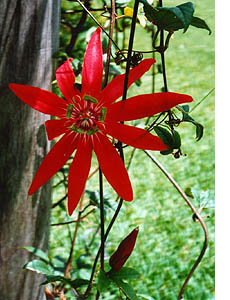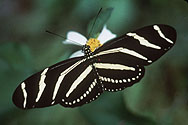 |
| Ken Nugent, surrounded by the plants he propagates and nurtures for the Garden and for Garden members. |
Passion Flower Vines
By Ken Neugent, Nursery Manager
These are a few of our favorite plants . . .

Legend and romance surround the vine we call the passion flower - legend because of its historical associations with Christianity, and romance because of its suggestion of romantic passion. Early explorers and missionaries to this hemisphere, specifically to South America, named these dramatic vines Passiflora or passion flower to help in their conversion of native Americans to Christianity. They saw and used the beautiful intricate flower parts to tell the story of the death of Jesus, making the story more memorable to listeners. The legend they told is that the passion flower's ten petals and sepals represent the ten apostles present at the crucifixion. The filaments portrayed the crown of thorns, or the halo about Jesus' head. The stamens, of which there are five, suggest the five wounds to Christ's hands, feet and torso. Other parts of the flower and leaves are also used to represent aspects of Christ's passion.
Although I enjoy this and other stories that relate to the passion flower, it is my favorite plant because of great landscaping potential. It provides dappled shade on an arbor, it blooms in a wide range of colors, and its fruit is a delightful bonus. With its spectacular, fragrant blossoms, the passion flower will add a touch of romance to any garden.

Passion flowers are native to South America, which is home to 95% of the five hundred species. A vigorous and rapid climber, it is favored for its ability to supply shade, color, nectar, and fragrance virtually all year. Beside color from its blossoms, it attracts specific butterflies, which feed on the nectar and pollen. These butterflies are easily recognized by their large eyes, long antenna, and long wings. The zebra and postman butterflies are other examples of these passion flower lovers. Though grown mostly as an ornamental, some twenty species of passion flower are edible, and four or five species are grown commercially. The most popular, of course, is Passiflora edulis. Its fruit is eaten fresh or used in drinks, pies, jams, and ice cream. Some say that passion fruit has aphrodisiac qualities, and that is how it got its name.
As ornamental vines, passion flowers are undemanding. Any well drained fertile soil should keep them happy, and they thrive in sun or part-shade. You'll find that the trick is to keep the vine within your desired limits.
Passion flowers are vigorous climbers, using tendrils (whip-like growths that cling and curl around whatever they touch) to reach the heights. At first the tendrils grow straight out and feel around for something to grab. They grip the first object they touch, twisting around it for support. The twisting draws the stem closer to the support. As the plant grows, more tendrils are produced and the process is repeated.
To keep your passion flower vine beautiful, prune regularly when new growth starts in spring or during active growing periods. Allowing some parts to naturally droop often induces flowering.
The jury is still out on the origin of the passion flower's name. Why not grow one yourself and when you show people your garden, you can choose the story that suits your audience.
Garden News, November 1998